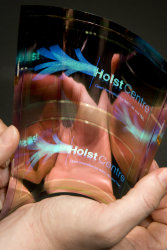PLACE-IT: Electronics-to-wear light up health care
The new components are flexible, stretchable, strong and light – so much so that they can easily adapt to the contours and movement of the human body. And that opens the door to a vast new array of applications, from smart bandages and internal organ monitors in the health care industry, e-clothing for the fashion and road safety sectors, to smart lighting inside cars, trains and planes. The work of the PLACE-IT(opens in new window) partners heralds the dawn of a new industry to accommodate this revolutionary flexible technology. You’ve heard of e-books, e-billing and e-health: now come e-textiles! The world of cyber skins A consortium of 12 partners, led by the Dutch multinational Royal Philips(opens in new window) , PLACE-IT has already demonstrated potentially successful products in the e-textiles sector and now progress in this area will be taken up by a new three-year FP7 project, TERASEL(opens in new window) , which will work on making flat circuits more elastic. PLACE-IT mainly focused on forming electronics to cover human or automotive bodies, a kind of ‘cyber skin’ that can adapt its shape to the function required without breaking any of the infinitesimal connections that make up the tiny microelectronic circuits powering all manner of applications these days. ‘Uncontrolled movement and body shape are demanding on technologies, and a certain percentage of stretch ability is required if electronics are to fulfil this demand,’ explains PLACE-IT coordinator Koen van Os(opens in new window) , specialist senior scientist at Philips in Eindhoven, the Netherlands. ‘Without this stretch ability, large area electronics create air-gaps and pressure points between device and skin, or sharp folding lines and cracks in the device itself,’ he added. Health care, fashion and automotive applications One of the most innovative products developed by the team in its demonstrators is BlueTouch phototherapy, a pain relief patch already commercialised by Philips to provide effective pain relief, particularly for back ache. Blue light bandages developed by Philips are bendable and comfortable enough to be worn on the back all day every day if need be. BlueTouch developed as a product during the project, was clinically proofed and is now a CE-certified medical device on sale to patients in the UK and Germany since spring 2012. One of the German partners, ZMF medical research centre(opens in new window) , has also shown that blue light affects biochemical processes. In this way, it can be used to measure the working of kidneys using a flexible patch to pick up on a fluorescent indicator, FITC-Sinistrin, and measure the function of the organs. The team hopes this product will help detect terminal renal disease at an early stage. Seventeen universities and five major drugs companies are using the device for research and safety assessment of new drugs. Jobs have also been created through a start-up, Mannheim Pharma & Diagnostics, which aims to sell the renal monitor and FITC-Sinistrin. The use of small LEDs in clothing has also been developed. Concert performers like the Black Eyed Peas have already trialled e-textile costumes containing OLED lighting technology in the shape of ultra-thin light-emitting foils. Automotive lighting is another area where PLACE-IT partners, including Germany’s Freudenberg technology group(opens in new window) , its textile research institute http://www.titv-greiz.de/index.php?id=503 & L=1 (TITV-Greiz) and Spain’s Grupo Antolin(opens in new window) , have been working. They have designed novel, ‘beyond-the-bulb’ lighting technologies into vehicle ‘skins’, such as ceilings (for interior illumination) and sun visors (for vanity lights) in a functional, energy-efficient and cost-effective way. PLACE-IT is a EUR 16 million project, with EUR 10.8 million funded by the European Union's Seventh Framework Programme(opens in new window) (FP7). The project started in February 2010 and ended in November 2013. Read this article in Dutch here(opens in new window) Link to project on CORDIS(opens in new window) Link to project website(opens in new window) European Commission's Digital Agenda(opens in new window)



